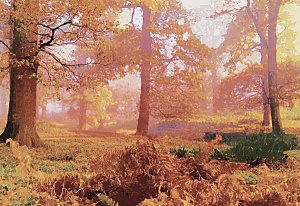|
|
 |
|
Richmond upon Thames
|
 |
|
This is London’s greatest Royal Park,
extending over 2,500 acres south-east of Richmond, so it only qualifies as a ‘hidden corner’ by virtue of its
distance from the city centre. Charles I created the park in 1637, ordering its brick-walled enclosure so that he might hunt
deer. The act was immensely unpopular with local people, even though the King allowed them to walk and to gather firewood
here – a right that still exists. When Charles was beheaded, Parliament granted the park to the City of London, which
prudently restored it to Charles II on his enthronement. In 1751 Princess Amelia took up residence in the White Lodge (built
as a retreat for her father, George II) and excluded the public from the park until the courts overturned the ban seven years
later. As a result of public pressure Edward VII disbanded the Royal Hunt and opened the park to the public in March 1904.
Viscount Sidmouth – in his role as Deputy Ranger – introduced a series of plantations from 1819 onwards, principally
of oak trees, but also Spanish chestnut, beech, hornbeam, sycamore and larch. There are now more than a dozen woods, the most
beautiful of which is the 42-acre Isabella Plantation, extensively replanted with ericacious shrubs in the 1950s and 60s.
Sidmouth Wood has become a bird sanctuary; over a hundred different species have been recorded throughout the park, and pheasant
and partridge are artificially raised. Richmond Park has several hundred fallow and red deer, and a wide variety of woodland
wildlife including badgers and foxes – although the official mole-catcher has been made redundant. Sheep ceased to be
grazed in 1980. At the centre of the park are the Pen Ponds, where coarse fishing is allowed by permit.
|
 |
|
|
|
 |

|
| The park is best known for its wide open spaces but has some luxuriant woodland, seen here in autumn |
George V granted permission for the park’s
eastern section to be turned into a golf course, on the understanding that it was for ‘artisans’; who could not
afford membership of a private club. The course opened in 1923 and was followed by another two years later. The White Lodge,
which has been occupied by a succession of princes and princesses, now belongs to the Royal Ballet school. Pembroke Lodge
was the home of Lord Russell, the Prime Minister, and his grandson, Bertrand Russell, the philosopher. Princess Alexandra lives at Thatched House Lodge, which, in its present form, is largely the work of Sir John Soane.
|
 |
|
|
|
|
|
Postcode areas and postal districts: Mainly Richmond, TW10, with parts in SW14, SW15 and Kingston upon Thames, KT2
Further reading: Joanna Jackson, A Year in the Life of Richmond Park, Frances Lincoln, 2003
Text and selected images are reproduced with the permission
of Chambers but may differ from the published versions
All content © 2005–2010
|
|
|
 |

